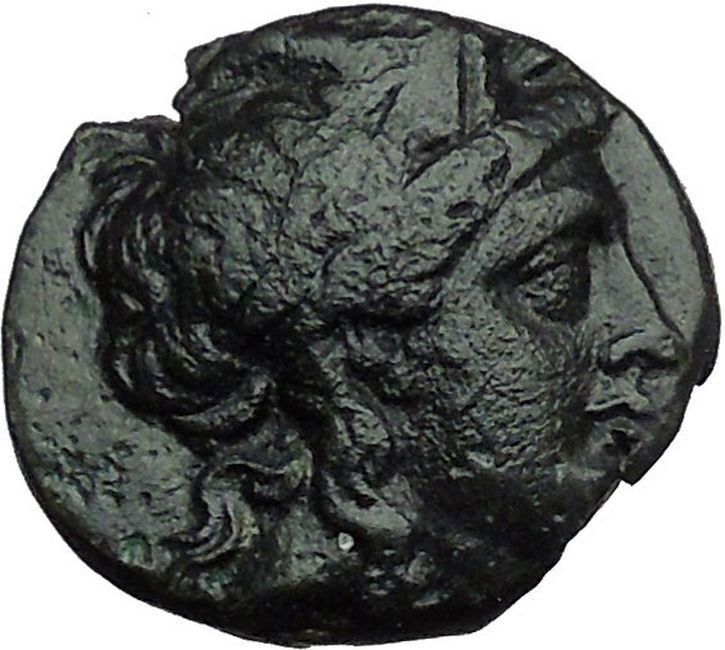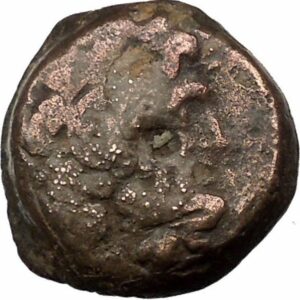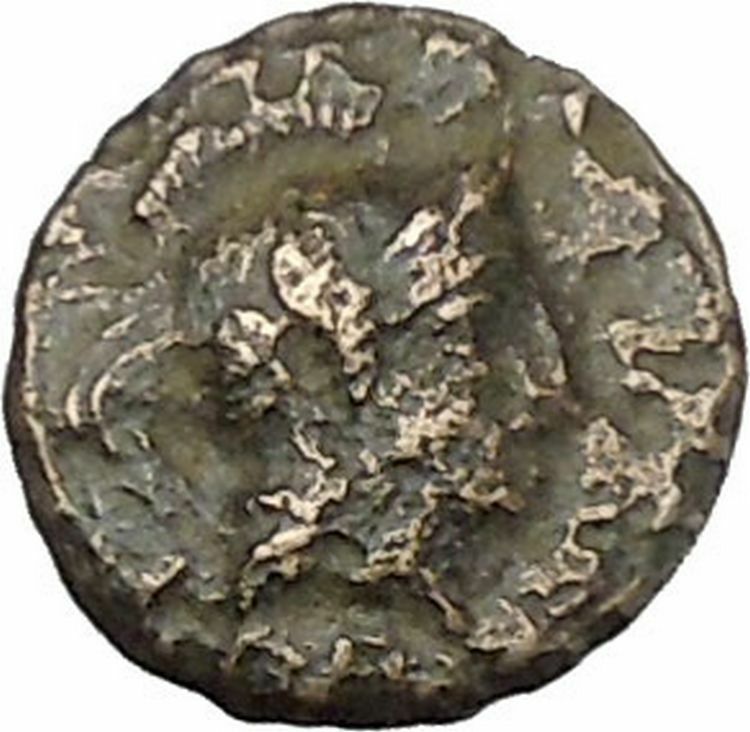|
Arab Kingdom of
Nabataea
Rabbel II – King: 70-106 A.D.
Bronze 17mm (4.16 grams) Petra mint, Struck 75/76 A.D.
Reference: Meshorer, Nabataea 146
Jugate portraits of Rabbel II and Shuqailat right, both laureate, head of Rabbel
with very long hair covering nape of neck, but of Shuqailat draped.
Two cornucopiae crossed; between them, above and below, in three lines,
inscription רבאל/שקילת/אמה (Rabbel/Shuqailat/his mother)
The north-Arabian kingdom of the Nabataeans, with their capital at Petra,
continued in existence until the early years of the 2nd Century A.D., when
emperor Trajan created the Roman province of Arabia.
You are bidding on the exact item pictured,
provided with a Certificate of Authenticity and Lifetime Guarantee of
Authenticity.
The cornucopia (from Latin cornu copiae) or horn of
plenty is a symbol of abundance and nourishment, commonly a large
horn-shaped container overflowing with produce, flowers, nuts, other
edibles, or wealth in some form. Originating in
classical antiquity
, it has continued
as a symbol in
Western art
, and it is particularly
associated with the
Thanksgiving
holiday in
North America
.
In Mythology
Mythology
offers multiple
explanations of the origin
of the cornucopia.
One of the best-known involves the birth and nurturance of the infant
Zeus, who had to be hidden from his devouring father
Cronus
. In a cave on
Mount Ida
on the island of
Crete
, baby Zeus was cared for and protected by
a number of divine attendants, including the goat
Amalthea
(“Nourishing Goddess”), who fed him
with her milk. The suckling future king of the gods had unusual abilities and
strength, and in playing with his nursemaid accidentally broke off one of her
horns
, which then had the divine power to
provide unending nourishment, as the foster mother had to the god.
In another myth, the cornucopia was created when
Heracles
(Roman
Hercules
) wrestled with the river god
Achelous
and wrenched off one of his horns;
river gods were sometimes depicted as horned. This version is represented in the
Achelous and Hercules
mural painting
by the
American Regionalist
artist
Thomas Hart Benton
.
The cornucopia became the attribute of several
Greek
and
Roman deities
, particularly those associated
with the harvest, prosperity, or spiritual abundance, such as personifications
of Earth (Gaia
or
Terra
); the child
Plutus
, god of riches and son of the grain
goddess Demeter
; the
nymph
Maia
; and
Fortuna
, the goddess of luck, who had the power
to grant prosperity. In
Roman Imperial cult
, abstract Roman deities who
fostered peace (pax
Romana) and prosperity were also depicted with a cornucopia,
including Abundantia
, “Abundance” personified, and
Annona
, goddess of the
grain supply to the city of Rome
.
Pluto
, the classical ruler of the underworld in
the
mystery religions
, was a giver of agricultural,
mineral and spiritual wealth, and in art often holds a cornucopia to distinguish
him from the gloomier Hades
, who holds a
drinking horn
instead.
Modern depictions
In modern depictions, the cornucopia is typically a hollow, horn-shaped
wicker basket filled with various kinds of festive
fruit
and
vegetables
. In North America, the cornucopia
has come to be associated with
Thanksgiving
and the harvest. Cornucopia is
also the name of the annual November Wine and Food celebration in
Whistler
, British Columbia, Canada. Two
cornucopias are seen in the
flag
and
state seal
of
Idaho
. The Great
Seal
of
North Carolina
depicts Liberty standing and
Plenty holding a cornucopia. The coat of arms of
Colombia
,
Panama
,
Peru and
Venezuela
, and the Coat of Arms of the State of
Victoria, Australia
, also feature the
cornucopia, symbolising prosperity.
The horn of plenty is used on body art and at Halloween, as it is a symbol of
fertility, fortune and abundance.
-
Base of a statue of
Louis XV of France
Rabel II Soter (ar-Rabil) was the last ruler of the
kingdom of the Nabataea
, ruling from AD
70 to 106.
After the death of his father,
Malichus II
, ar-Rabil still a child, ascended
to the throne. His mother,
Shaqilath
, assumed control of the government in
the early years. His sister Gamilath became queen of the
Nabateans
. Ar-Rabil gave himself the title “Soter”
(“Savior of the People”). After his death in 106, the
Roman emperor
Trajan
faced practically no resistance and
conquered the
Nabataean kingdom
on 22 March 106. It became
the Roman province of
Arabia Petraea
, with
Bosra
becoming its provincial capital.
Shaqilath is the daughter of
Aretas IV
of the
Nabataeans
. She ruled jointly with her
husband-brother
Malichus II
(40-70). After his death she was
regent for her son
Rabel II
.
Copper and silver coins
where she is depicted
with her husband and coins of her with her son have been recovered. Some of
these coins are dated with regnal years to the left of the queen.

Al Khazneh or The Treasury at Petra
|
Petra (Arabic:
البتراء, Al-Batrāʾ;
Ancient Greek
: Πέτρα) is a
historical
and
archaeological
city in the southern
Jordanian
governorate of
Ma’an
that is famous for its
rock-cut architecture
and water conduit system.
Another name for Petra is the Rose City due to the color of the stone out of
which it is carved.
Established possibly as early as 312 BC as the capital city of the
Nabataeans
, it is a symbol of Jordan, as well
as Jordan’s most-visited tourist attraction. It lies on the slope of
Jebel al-Madhbah
(identified by some as the
biblical Mount Hor
[4])
in a
basin
among the mountains which form the
eastern flank of Arabah
(Wadi Araba), the large valley running
from the Dead Sea
to the
Gulf of Aqaba
. Petra has been a
UNESCO
World Heritage Site
since 1985.
The site remained unknown to the
Western world
until 1812, when it was
introduced by
Swiss
explorer
Johann Ludwig Burckhardt
. It was described as
“a rose-red city half as old as time” in a
Newdigate Prize
-winning poem by
John William Burgon
. UNESCO has described it as
“one of the most precious cultural properties of man’s cultural heritage”. See:
UNESCO Intangible Cultural Heritage Lists
.
Petra was chosen by the
Smithsonian Magazine
as one of the “28
Places to See Before You Die”.
The Nabataean kingdom, also named Nabatea(Arabic:نبطية) (many
times spelled Nabatean), was an Arabic political state of the
Nabataeans
which existed during
classical antiquity
and was annexed by the
Roman Empire
in CE 106.
Geography
Located between the
Sinai Peninsula
and the
Arabian Peninsula
, its northern neighbour was
the kingdom of Judea
, and its south western neighbour was
Ptolemaic Egypt
. Its capital was the city of
Petra
in
Jordan
, and it included the towns of
Bostra
,
Mada’in Saleh
, and
Nitzana
.
Petra was a wealthy trading town, located at a convergence of several
important trade routes
. One of them was the
Incense Route
which was based around the
production of both myrrh
and
frankincense
in southern Arabia, and ran
through Mada’in Saleh to Petra. From here the aromatics were distributed
throughout the Mediterranean region.
History
Nabataean origins date from a time when they were nomadic pastoralists in the
Negev
and the
Sinai Peninsula
during
Achaemenid Persian
rule, around the 4th century
BCE.
Nabateans and
Hasmoneans
The Nabataeans were allies of the first
Hasmoneans
in their struggles against the
Seleucid
monarchs. They then became rivals of
the Judaean dynasty, and a chief element in the disorders which invited
Pompey
‘s intervention in
Judea
. Many Nabataeans were forcefully
converted to Judaism
by the
Hasmonean
king
Alexander Jannaeus
. It was this King who, after
putting down a local rebellion, invaded and occupied the Nabataean towns of
Moab and Gilead
and imposed a tribute of an unspecified
amount. Obodas I
knew that Alexander would attack, so
was able to ambush Alexander’s forces near Gaulane (Golan)
destroying the Judean army in 90 BCE. Under the reign of
Aretas III
(87 to 62 BCE) the kingdom seems to
have reached its territorial zenith, but was defeated by a Roman army under the
command of
Marcus Aemilius Scaurus
. Scaurus’ army even
besieged Petra, but eventually a compromise was negotiated. Paying a tribute,
Aretas III received the formal recognition by the
Roman Republic
.
The Nabatean kingdom saw itself slowly surrounded by the expanding
Roman Empire
, which conquered Egypt and annexed
Hasmonean Judea. While the Nabatean kingdom managed to preserve its formal
independence, it became a client kingdom under the influence of Rome.
Roman annexation
A map of the
Roman Empire
, at its greatest
extent, showing the territory of Trajan’s Nabatæan conquests in the
southeast.
Main article:
Arabia Petraea
In 106 CE, during the reign of Roman emperor
Trajan
, the last king of the Nabatean kingdom
Rabbel II Soter
died. This event might have
prompted the official annexation of Nabatea to the Roman Empire, although the
formal reasons, and the exact manner of annexation, are unknown.
Some epigraphic evidence suggests a military campaign, commanded by
Cornelius Palma
, the governor of
Syria
. Roman forces seem to have come from
Syria and also from
Egypt
. It is clear that by 107 CE Roman legions
were stationed in the area around Petra and Bostra, as is shown by a papyrus
found in Egypt. The kingdom was annexed by the empire, becoming the province of
Arabia Petraea
. Trade seems to have largely
continued thanks to the Nabataens’ undiminished talent for trading.
Under Hadrian
, the
limes Arabicus
ignored most of the Nabatæan
territory and ran northeast from Aila (modern
Aqaba
) at the head of the
Gulf of Aqaba
. A century later, during the
reign of
Alexander Severus
, the local issue of coinage
came to an end. There is no more building of sumptuous tombs, owing apparently
to a sudden change in political ways, such as an invasion by the neo-Persian
power under the
Sassanid Empire
.
The city of Palmyra
, for a time the capital of the
breakaway
Palmyrene Empire
(fl. 130–270), grew in
importance and attracted the Arabian trade away from Petra.
|











